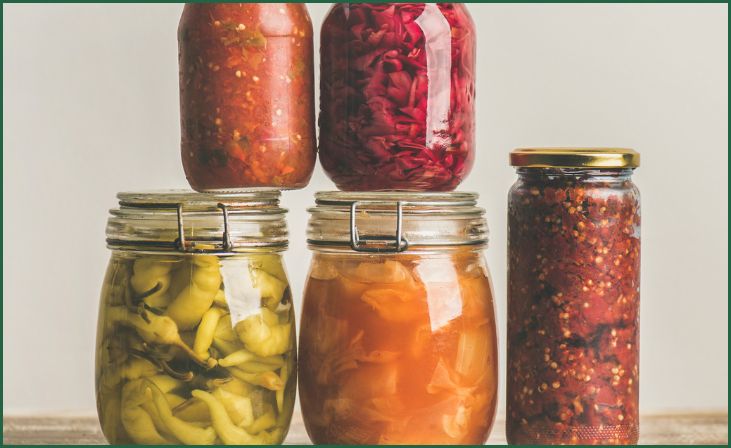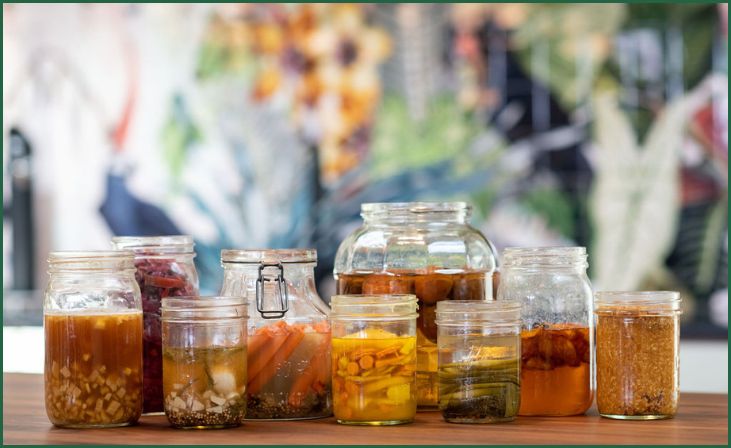Why Do Micro Organisms Ferment Our Food? – Welcome to a fascinating exploration into the world of microorganisms and their culinary prowess. Have you ever wondered why your favorite foods undergo fermentation? In this blog, we’ll delve into the science behind the microbial magic that transforms ordinary ingredients into extraordinary delicacies.
Table of Contents
ToggleWhy Do Micro Organisms Ferment Our Food?
Here you will get to know everything about Why Do Micro Organisms Ferment Our Food:
The Science Behind Food Fermentation

Food fermentation is a fascinating biological process driven by the activity of microorganisms, predominantly bacteria and yeast. This natural transformation occurs when these microorganisms metabolize sugars present in food, producing various byproducts such as acids and alcohol. The intricate science behind food fermentation involves several key steps:
- Microorganisms Involved:
- Bacteria: Lactic acid bacteria and acetic acid bacteria are common players in the fermentation game. Lactic acid bacteria are responsible for the fermentation of sugars into lactic acid, while acetic acid bacteria contribute to the production of acetic acid, giving certain fermented foods their characteristic tang.
- Yeast: This single-celled fungus plays a crucial role in alcoholic fermentation. Yeast converts sugars into alcohol and carbon dioxide, imparting distinct flavors to fermented beverages and bread.
- Fermentation Process:
- Microorganisms initiate the fermentation process by breaking down sugars present in the food. This process serves as a means of energy production for the microorganisms.
- The breakdown of sugars results in the production of organic acids, alcohol, or a combination of both, depending on the specific microorganisms involved in the fermentation.
- Byproducts of Fermentation:
- Acids: Lactic acid, acetic acid, and other organic acids contribute to the tangy and sour flavors in fermented foods. These acids also act as natural preservatives, extending the shelf life of the products.
- Alcohol: In alcoholic fermentation, yeast converts sugars into alcohol and carbon dioxide. This process is commonly observed in the production of beer, wine, and other fermented beverages.
Understanding the science behind food fermentation allows us to appreciate the complexity of this natural phenomenon. The interactions between microorganisms and food components result in a myriad of flavors, textures, and aromas that make fermented foods a diverse and culturally significant part of culinary traditions worldwide. Keep reading to know more about Why Do Micro Organisms Ferment Our Food.
Also Read: Salts for Fermenting Foods
Culinary Transformation
The culinary transformation brought about by food fermentation is a captivating process that elevates ordinary ingredients to extraordinary culinary delights. This transformative journey involves the interplay of microorganisms, time, and specific environmental conditions. Let’s delve into the key aspects of culinary transformation through fermentation:
- Examples of Fermented Foods:
- Sauerkraut: Finely shredded cabbage undergoes lactic acid fermentation, resulting in a tangy and crunchy condiment.
- Yogurt: Milk is fermented by lactic acid bacteria, creating a creamy and tangy product packed with probiotics.
- Kimchi: A staple in Korean cuisine, kimchi involves fermenting vegetables like cabbage and radishes with a spicy mix of seasonings.
- Enhancement of Flavors and Textures:
- Flavor Development: During fermentation, microorganisms produce various compounds that contribute to the unique flavors of fermented foods. For instance, the tanginess in sauerkraut comes from lactic acid, while the characteristic taste of sourdough bread is a result of acid produced by wild yeast.
- Texture Improvement: Fermentation can alter the texture of foods, making them more palatable. Yogurt, for example, undergoes changes in texture as milk proteins are partially broken down.
- Art of Preservation:
- Fermentation has long been utilized as a method of preserving food. The acidic environment created during fermentation inhibits the growth of harmful bacteria, preventing spoilage and extending the shelf life of the product.
- Diverse Culinary Applications:
- Fermented ingredients often become integral components in cooking. Soy sauce, miso, and fish sauce, for example, are indispensable in many Asian cuisines, providing depth and umami to a wide array of dishes.
- Microbial Alchemy:
- The microbial communities involved in fermentation act as culinary alchemists, transforming the chemical composition of ingredients. This alchemy produces complex flavors and aromas that define the character of each fermented product.
Understanding the culinary transformation facilitated by fermentation allows us to appreciate the diversity and richness of global cuisines. From pickles to cheese, the art of fermentation not only enhances the sensory experience of food but also preserves cultural traditions that have been passed down through generations. Scroll down to have more information on Why Do Micro Organisms Ferment Our Food.
Don't just scroll, subscribe!
BuzzTrail's unique web-stories are the cure for boredom you've been waiting for.
Also Read: Sterilize your Fermenting Jars
Preservation and Nutritional Value
Food fermentation serves as a dual-purpose marvel, not only enhancing flavors but also acting as a powerful method of preservation while imparting notable nutritional benefits. Let’s delve into the intricate relationship between fermentation, preservation, and nutritional value:
- Historical Context of Food Preservation:
- Fermentation has been a cornerstone of food preservation for centuries. Long before refrigeration, communities worldwide relied on fermentation to safeguard perishable foods from spoilage and extend their usability.
- Shelf Life Extension:
- The preservation aspect of fermentation is primarily attributed to the production of organic acids, such as lactic acid and acetic acid. These acids create an acidic environment that inhibits the growth of harmful bacteria, molds, and other spoilage microorganisms.
- Fermented foods, from pickles to kimchi, sauerkraut to miso, owe their prolonged shelf life to this natural preservation process. This historical method remains relevant today, offering an alternative to modern preservation techniques.
- Nutritional Benefits of Fermented Foods:
- Probiotics: One of the most significant nutritional advantages of fermented foods is the presence of probiotics. These are beneficial bacteria that positively influence the gut microbiome, promoting digestive health and overall well-being. Probiotics can be found in large amounts in yogurt, kefir, and fermented veggies.
- Nutrient Enhancement: Some nutrients can be used by the body more easily after fermentation. For instance, the fermentation of grains or legumes can break down compounds like phytic acid, unlocking essential minerals and making them more easily absorbed by the body.
- B-Vitamins and Enzymes: Fermentation also contributes to the synthesis of B-vitamins and the activation of enzymes, further enhancing the nutritional profile of the fermented product.
- Cultural Significance:
- Many traditional fermented foods have become cultural staples, not only for their distinctive flavors but also for their role in ensuring food availability during different seasons. Examples include the Korean tradition of making kimchi in abundance during the harvest season for consumption throughout the year.
Understanding the preservation and nutritional aspects of food fermentation allows us to appreciate it as a holistic and sustainable culinary practice. Beyond the taste and cultural significance, fermented foods contribute to a balanced and nourishing diet, connecting us to a rich tapestry of culinary history. To learn more about Why Do Micro Organisms Ferment Our Food, keep reading.
The Symbiotic Relationship

The symbiotic relationship between humans and microorganisms in the context of food fermentation is a captivating interplay that goes beyond the realms of culinary science. This intricate connection highlights the mutual benefits that both parties derive from the fermentation process:
- Microbial Partnerships:
- Humans have harnessed the power of select microorganisms, such as bacteria and yeast, to facilitate the fermentation of various foods. These microorganisms act as culinary co-conspirators, transforming raw ingredients into flavorful and preserved delicacies.
- Initiating the Fermentation Process:
- Humans play a pivotal role in initiating the fermentation process by creating the conditions necessary for microbial activity. This includes providing the right environment, such as a suitable temperature, pH level, and the presence of specific nutrients, to encourage the growth of desired microorganisms.
- Microbial Metabolism and Byproduct Production:
- As microorganisms metabolize sugars in the food, they produce byproducts like acids or alcohol. This metabolic activity not only enhances the flavor and texture of the food but also contributes to its preservation.
- Preserving Cultural Traditions:
- The symbiotic relationship extends beyond the biochemical reactions. Humans and microorganisms collaborate to preserve cultural traditions through the creation of unique fermented foods. Each community’s choice of microorganisms and ingredients imparts distinct characteristics to their traditional fermented dishes, creating a tapestry of culinary diversity.
- Reciprocal Benefits:
- While humans provide the environment and ingredients for fermentation, they reap the rewards of enhanced flavors, improved shelf life, and nutritional benefits from the final product.
- Microorganisms benefit from this relationship by finding a hospitable environment for growth and reproduction. Certain strains of bacteria, such as those in yogurt cultures, depend on humans for propagation and perpetuation.
- Gut Microbiome and Health:
- The consumption of fermented foods contributes to the health of the human gut microbiome. Probiotics present in these foods positively impact the balance of gut bacteria, promoting digestive health and overall well-being.
- Environmental Impact:
- The symbiotic relationship extends to the broader environment. Fermentation, as a natural and low-energy process, aligns with sustainable practices, showcasing a harmonious connection between humans, microorganisms, and the planet.
Understanding the symbiotic relationship between humans and microorganisms in food fermentation adds depth to the appreciation of culinary traditions. This collaboration not only results in delectable and culturally significant foods but also exemplifies a harmonious interaction between humans and the microbial world. Keep scrolling to have more information on Why Do Micro Organisms Ferment Our Food.
Also Read: Can You Ferment Different Foods in the Same Room?
Conclusion
As we wrap up our journey into the microbial realms of food fermentation, it’s clear that these tiny organisms play a big role in shaping the flavors and textures we savor. From sauerkraut to yogurt, the art of fermentation is a testament to the symbiotic relationship between humans and microorganisms. Embrace the science, savor the taste, and marvel at the wonders happening in your kitchen. We hope this blog has cleared all your queries on Why Do Micro Organisms Ferment Our Food.
FAQs
Why do microorganisms ferment our food?
Why do microorganisms ferment our food?
Microorganisms, such as bacteria and yeast, break down sugars and produce acids or alcohol during the fermentation process. This not only preserves food but also enhances its flavor, texture, and nutritional value. It’s nature’s way of turning the ordinary into something extraordinary!
Is fermented food good for our health?
Is fermented food good for our health?
Absolutely! Probiotics are good bacteria that help keep your gut microbiome healthy. Fermented foods have a lot of them. Consuming these foods can aid digestion, boost the immune system, and contribute to overall well-being. So, go ahead and indulge in the goodness of fermented delights for a happy and healthy gut.

